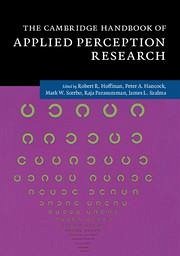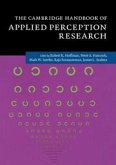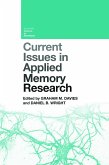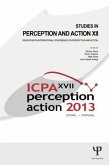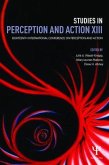The Cambridge Handbook of Applied Perception Research 2 Volume Paperback Set
Herausgeber: Hoffman, Robert R; Szalma, James L; Parasuraman, Raja; Scerbo, Mark W; Hancock, Peter A
The Cambridge Handbook of Applied Perception Research 2 Volume Paperback Set
Herausgeber: Hoffman, Robert R; Szalma, James L; Parasuraman, Raja; Scerbo, Mark W; Hancock, Peter A
- Broschiertes Buch
- Merkliste
- Auf die Merkliste
- Bewerten Bewerten
- Teilen
- Produkt teilen
- Produkterinnerung
- Produkterinnerung
Focusing on everything from basic research practices to cutting-edge technology, this book is essential for student learning and professional research.
Andere Kunden interessierten sich auch für
![The Cambridge Handbook of Applied Perception Research 2 Volume Hardback Set The Cambridge Handbook of Applied Perception Research 2 Volume Hardback Set]() The Cambridge Handbook of Applied Perception Research 2 Volume Hardback Set451,99 €
The Cambridge Handbook of Applied Perception Research 2 Volume Hardback Set451,99 €![The Cambridge Handbook of Creativity and Personality Research The Cambridge Handbook of Creativity and Personality Research]() The Cambridge Handbook of Creativity and Personality Research76,99 €
The Cambridge Handbook of Creativity and Personality Research76,99 €![Sensation and Perception Sensation and Perception]() Bennett L SchwartzSensation and Perception218,99 €
Bennett L SchwartzSensation and Perception218,99 €![Applied Psycholinguistics Applied Psycholinguistics]() Marcel DanesiApplied Psycholinguistics37,99 €
Marcel DanesiApplied Psycholinguistics37,99 €![Current Issues in Applied Memory Research Current Issues in Applied Memory Research]() Current Issues in Applied Memory Research67,99 €
Current Issues in Applied Memory Research67,99 €![Studies in Perception and Action XII Studies in Perception and Action XII]() Studies in Perception and Action XII94,99 €
Studies in Perception and Action XII94,99 €![Studies in Perception and Action XIII Studies in Perception and Action XIII]() Studies in Perception and Action XIII106,99 €
Studies in Perception and Action XIII106,99 €-
-
-
Focusing on everything from basic research practices to cutting-edge technology, this book is essential for student learning and professional research.
Produktdetails
- Produktdetails
- Verlag: Cambridge University Press
- Seitenzahl: 1127
- Erscheinungstermin: 19. Oktober 2017
- Englisch
- Abmessung: 256mm x 191mm x 64mm
- Gewicht: 2195g
- ISBN-13: 9781107422230
- ISBN-10: 110742223X
- Artikelnr.: 42582350
- Herstellerkennzeichnung
- Libri GmbH
- Europaallee 1
- 36244 Bad Hersfeld
- gpsr@libri.de
- Verlag: Cambridge University Press
- Seitenzahl: 1127
- Erscheinungstermin: 19. Oktober 2017
- Englisch
- Abmessung: 256mm x 191mm x 64mm
- Gewicht: 2195g
- ISBN-13: 9781107422230
- ISBN-10: 110742223X
- Artikelnr.: 42582350
- Herstellerkennzeichnung
- Libri GmbH
- Europaallee 1
- 36244 Bad Hersfeld
- gpsr@libri.de
Part I. Background and Methodology: 1. Applied perception research: an introduction to this handbook
2. Some highlights in the history of applied perception research
3. Psychophysical methods and signal detection: recent advances in theory
4. The measurement of perceptual resources and workload
5. Methods and applications of eye tracking
6. Applied perception and neuroergonomics
Part II. Attention and Perceptual Processes: 7. Perception and attention: a multidimensional approach to human performance modeling
8. Attention as a cause and an effect of perception
9. Probing plasticity of attention and working memory processes induced by video game play
10. Visual attention and emotion: studying influence on a two-way street
11. Perception and human information processing in visual search
12. Motivation and emotion in sustained attention
13. Vigilance: a perceptual challenge
14. Psychology of time: basic and applied issues
Part III. Modality: 15. Multimodal and multisensory displays for perceptual tasks
16. Multi-modal and cross-modal perception: audition
17. Haptic perception
18. Visual information in the coordination and control of isometric force
19. Guidelines for vibrotactile display design: front-end, intensitive, and spatial considerations
20. Olfactory interfaces
Part IV. Perception in Context: 21. Biological motion perception
22. Perceptual segmentation of natural events: theory, methods, and applications
23. Attention in the wild: visual attention in complex, dynamic, and social environments
24. Perception of trust in automation
25. Applied ecological acoustics
26. Affordance perception research
27. Perceiving the nesting of affordances for complex goal-directed actions
28. Perception of collision
29. Hazard awareness in driving: measurement and training
Part V. Perception and Design: 30. Applied perception and virtual environment training systems
31. Using task analysis and computational cognitive models to design and evaluate interfaces
32. Interface design: a control theoretic context for a triadic meaning processing approach
33. Ecological interface design: a selective overview
34. Perceptual learning in the comprehension of animation and animated diagrams
35. Towards empirically verified cartographic displays
Part VI. Perception and Domains of Work and Professional Experience: 36. Perceptual learning and expertise
37. Noticing events in the visual workplace: the SEEV and NSEEV models
38. Sustained attention in operational settings
39. Using simulation to examine perceptual challenges faced by healthcare providers
40. Color vision in aviation
41. Eye, robot: visual perception and human-robot interaction
42. Human-robot interaction as extending human perception to new scales
43. Applied perception in military applications: detection of hidden explosive hazards
44. Situation awareness in command and control
45. Spatial orientation and motion perception in microgravity
46. Evaluating visually induced motion sickness
47. Predicting the future in perceptual-motor domains: perceptual anticipation, option generation, and expertise
Part VII. Individual and Population Differences: 48. Sustained attention in infants and children
49. Gender differences in time perception
50. Early visual processing abnormalities related to schizophrenia and autistic spectrum disorders
51. Considering older adults' perceptual capabilities in the design process
52. Comparative applied perception research: the case of working dogs
Part VIII. Pedagogical and Professional Issues: 53. Pedagogical issues in teaching the psychology of perception
54. Graduate training and experiences for careers in applied experimental psychology.
2. Some highlights in the history of applied perception research
3. Psychophysical methods and signal detection: recent advances in theory
4. The measurement of perceptual resources and workload
5. Methods and applications of eye tracking
6. Applied perception and neuroergonomics
Part II. Attention and Perceptual Processes: 7. Perception and attention: a multidimensional approach to human performance modeling
8. Attention as a cause and an effect of perception
9. Probing plasticity of attention and working memory processes induced by video game play
10. Visual attention and emotion: studying influence on a two-way street
11. Perception and human information processing in visual search
12. Motivation and emotion in sustained attention
13. Vigilance: a perceptual challenge
14. Psychology of time: basic and applied issues
Part III. Modality: 15. Multimodal and multisensory displays for perceptual tasks
16. Multi-modal and cross-modal perception: audition
17. Haptic perception
18. Visual information in the coordination and control of isometric force
19. Guidelines for vibrotactile display design: front-end, intensitive, and spatial considerations
20. Olfactory interfaces
Part IV. Perception in Context: 21. Biological motion perception
22. Perceptual segmentation of natural events: theory, methods, and applications
23. Attention in the wild: visual attention in complex, dynamic, and social environments
24. Perception of trust in automation
25. Applied ecological acoustics
26. Affordance perception research
27. Perceiving the nesting of affordances for complex goal-directed actions
28. Perception of collision
29. Hazard awareness in driving: measurement and training
Part V. Perception and Design: 30. Applied perception and virtual environment training systems
31. Using task analysis and computational cognitive models to design and evaluate interfaces
32. Interface design: a control theoretic context for a triadic meaning processing approach
33. Ecological interface design: a selective overview
34. Perceptual learning in the comprehension of animation and animated diagrams
35. Towards empirically verified cartographic displays
Part VI. Perception and Domains of Work and Professional Experience: 36. Perceptual learning and expertise
37. Noticing events in the visual workplace: the SEEV and NSEEV models
38. Sustained attention in operational settings
39. Using simulation to examine perceptual challenges faced by healthcare providers
40. Color vision in aviation
41. Eye, robot: visual perception and human-robot interaction
42. Human-robot interaction as extending human perception to new scales
43. Applied perception in military applications: detection of hidden explosive hazards
44. Situation awareness in command and control
45. Spatial orientation and motion perception in microgravity
46. Evaluating visually induced motion sickness
47. Predicting the future in perceptual-motor domains: perceptual anticipation, option generation, and expertise
Part VII. Individual and Population Differences: 48. Sustained attention in infants and children
49. Gender differences in time perception
50. Early visual processing abnormalities related to schizophrenia and autistic spectrum disorders
51. Considering older adults' perceptual capabilities in the design process
52. Comparative applied perception research: the case of working dogs
Part VIII. Pedagogical and Professional Issues: 53. Pedagogical issues in teaching the psychology of perception
54. Graduate training and experiences for careers in applied experimental psychology.
Part I. Background and Methodology: 1. Applied perception research: an introduction to this handbook
2. Some highlights in the history of applied perception research
3. Psychophysical methods and signal detection: recent advances in theory
4. The measurement of perceptual resources and workload
5. Methods and applications of eye tracking
6. Applied perception and neuroergonomics
Part II. Attention and Perceptual Processes: 7. Perception and attention: a multidimensional approach to human performance modeling
8. Attention as a cause and an effect of perception
9. Probing plasticity of attention and working memory processes induced by video game play
10. Visual attention and emotion: studying influence on a two-way street
11. Perception and human information processing in visual search
12. Motivation and emotion in sustained attention
13. Vigilance: a perceptual challenge
14. Psychology of time: basic and applied issues
Part III. Modality: 15. Multimodal and multisensory displays for perceptual tasks
16. Multi-modal and cross-modal perception: audition
17. Haptic perception
18. Visual information in the coordination and control of isometric force
19. Guidelines for vibrotactile display design: front-end, intensitive, and spatial considerations
20. Olfactory interfaces
Part IV. Perception in Context: 21. Biological motion perception
22. Perceptual segmentation of natural events: theory, methods, and applications
23. Attention in the wild: visual attention in complex, dynamic, and social environments
24. Perception of trust in automation
25. Applied ecological acoustics
26. Affordance perception research
27. Perceiving the nesting of affordances for complex goal-directed actions
28. Perception of collision
29. Hazard awareness in driving: measurement and training
Part V. Perception and Design: 30. Applied perception and virtual environment training systems
31. Using task analysis and computational cognitive models to design and evaluate interfaces
32. Interface design: a control theoretic context for a triadic meaning processing approach
33. Ecological interface design: a selective overview
34. Perceptual learning in the comprehension of animation and animated diagrams
35. Towards empirically verified cartographic displays
Part VI. Perception and Domains of Work and Professional Experience: 36. Perceptual learning and expertise
37. Noticing events in the visual workplace: the SEEV and NSEEV models
38. Sustained attention in operational settings
39. Using simulation to examine perceptual challenges faced by healthcare providers
40. Color vision in aviation
41. Eye, robot: visual perception and human-robot interaction
42. Human-robot interaction as extending human perception to new scales
43. Applied perception in military applications: detection of hidden explosive hazards
44. Situation awareness in command and control
45. Spatial orientation and motion perception in microgravity
46. Evaluating visually induced motion sickness
47. Predicting the future in perceptual-motor domains: perceptual anticipation, option generation, and expertise
Part VII. Individual and Population Differences: 48. Sustained attention in infants and children
49. Gender differences in time perception
50. Early visual processing abnormalities related to schizophrenia and autistic spectrum disorders
51. Considering older adults' perceptual capabilities in the design process
52. Comparative applied perception research: the case of working dogs
Part VIII. Pedagogical and Professional Issues: 53. Pedagogical issues in teaching the psychology of perception
54. Graduate training and experiences for careers in applied experimental psychology.
2. Some highlights in the history of applied perception research
3. Psychophysical methods and signal detection: recent advances in theory
4. The measurement of perceptual resources and workload
5. Methods and applications of eye tracking
6. Applied perception and neuroergonomics
Part II. Attention and Perceptual Processes: 7. Perception and attention: a multidimensional approach to human performance modeling
8. Attention as a cause and an effect of perception
9. Probing plasticity of attention and working memory processes induced by video game play
10. Visual attention and emotion: studying influence on a two-way street
11. Perception and human information processing in visual search
12. Motivation and emotion in sustained attention
13. Vigilance: a perceptual challenge
14. Psychology of time: basic and applied issues
Part III. Modality: 15. Multimodal and multisensory displays for perceptual tasks
16. Multi-modal and cross-modal perception: audition
17. Haptic perception
18. Visual information in the coordination and control of isometric force
19. Guidelines for vibrotactile display design: front-end, intensitive, and spatial considerations
20. Olfactory interfaces
Part IV. Perception in Context: 21. Biological motion perception
22. Perceptual segmentation of natural events: theory, methods, and applications
23. Attention in the wild: visual attention in complex, dynamic, and social environments
24. Perception of trust in automation
25. Applied ecological acoustics
26. Affordance perception research
27. Perceiving the nesting of affordances for complex goal-directed actions
28. Perception of collision
29. Hazard awareness in driving: measurement and training
Part V. Perception and Design: 30. Applied perception and virtual environment training systems
31. Using task analysis and computational cognitive models to design and evaluate interfaces
32. Interface design: a control theoretic context for a triadic meaning processing approach
33. Ecological interface design: a selective overview
34. Perceptual learning in the comprehension of animation and animated diagrams
35. Towards empirically verified cartographic displays
Part VI. Perception and Domains of Work and Professional Experience: 36. Perceptual learning and expertise
37. Noticing events in the visual workplace: the SEEV and NSEEV models
38. Sustained attention in operational settings
39. Using simulation to examine perceptual challenges faced by healthcare providers
40. Color vision in aviation
41. Eye, robot: visual perception and human-robot interaction
42. Human-robot interaction as extending human perception to new scales
43. Applied perception in military applications: detection of hidden explosive hazards
44. Situation awareness in command and control
45. Spatial orientation and motion perception in microgravity
46. Evaluating visually induced motion sickness
47. Predicting the future in perceptual-motor domains: perceptual anticipation, option generation, and expertise
Part VII. Individual and Population Differences: 48. Sustained attention in infants and children
49. Gender differences in time perception
50. Early visual processing abnormalities related to schizophrenia and autistic spectrum disorders
51. Considering older adults' perceptual capabilities in the design process
52. Comparative applied perception research: the case of working dogs
Part VIII. Pedagogical and Professional Issues: 53. Pedagogical issues in teaching the psychology of perception
54. Graduate training and experiences for careers in applied experimental psychology.

